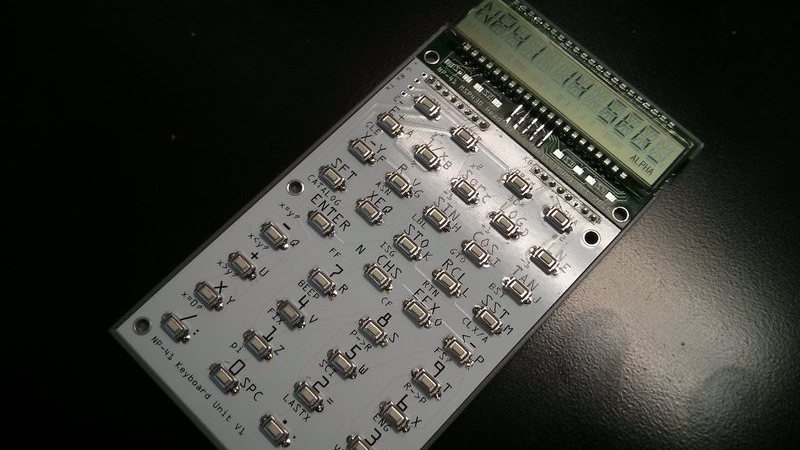The early HP Reverse Polish Notation calculators have a special place in the hearts of engineers and tinkerers as there are lots of projects involving them. They haven’t been produced in decades, but [Chris Chung] has used some open source code to create DIY hardware version of the HP-41 Reverse Polish Notation (RPN) calculator.
The open source code behind the calculator is the Nonpareil High-Fidelity Calculator Simulator, and [Chris] has used it along with a custom designed readout and PCBs to create a working prototype. The simulator uses the original byte code of the HP-41 so the its behavior is exactly the same as the original calculator.
[Chris] has designed the PCBs so that the buttons and the screen are separate and join together. This neat idea means that he can try out different screens or different button PCBs and mix-and-match to find the combination that works best. He’s also designed a 3D printed case for the calculator. He does prefer using the bare buttons on the board to the 3D printed ones he printed for use with the case.
We love calculators here so there have been a bunch of articles over the years. Check out the documentation that comes along with this open source calculator, or check out this pocket calculator that emulates two other pocket calculators!



















What is the obsession with making things so small that it’s impractical to use them?
I like calculators but this hack is is way too small for my fingers.
https://i.ebayimg.com/images/g/v-sAAOSwP~tW3yxk/s-l1600.jpg
Big enough for you?
This one is bigger: http://www.leningrad.su/museum/show_big.php?n=2512
http://www.leningrad.su/museum/37/deka-1.jpg
What about a 48GX equivalent?
I like it!
I wish him the best!
Thanks. I am doing well. Just being lazy recently. Will update the project log in a few days.
Great Project!
Even though the quality HP calculators are no longer made by HP… Swiss Micros makes a very close equivalent, that matches and actually surpasses the quality of the old HP Calculators. I bought a DM42 early this year and I am continually impressed with it and its quality.
For sure. I just acquired a Swiss Micros DM16L (RPN bin/hex/dec calculator) and it’s beautiful. I don’t do terribly much calculating that isn’t better documented in a spreadsheet, but I bit-twiddle more than I really should so that’s why I didn’t get the full scientific model. I had a 48GX until the keyboard gave out, and I don’t remember it being quite as “nice” as the DM16L.
Anyway, this NP-41 project actually looks like it would be fun to have just as a desk object. Love the custom-screened LCD, that’s some serious effort!
“HP-41 so the its behavior ” Might want to edit that…
With all the advancements in making PCBs, 3D printing, and laser cutting cheaply available, there’s still no good solution for making nice labeled key caps.
确实没有优秀的解决方案,但是我觉得可以用改造的3D打印机来做喷漆前的遮盖。然后手工喷漆,去除遮盖,最终用打印机在键帽上打印一层透明塑料来保护喷漆。
“There is really no good solution, but I think I can use the modified 3D printer to cover the paint before painting. Then hand-paint, remove the cover, and finally use the printer to print a layer of transparent plastic on the keycap to protect the paint.”
Why not scavenger key caps from other calculators?
If you want custom keycaps, there may not be another calculator to salvage keys from.
If I had the tools, I’d try – a milling ball on a Dremel, mounted on a 3D print bed, to engrave text on keys.
Followed by a disposable syringe, filled with resin in the colour of choice.
Sand down the edges when done, giving multiple text options per key without resorting to a backplate [with labels per key].
i want one to replace my old 1980 hp41
Note to all: It’s a HP-41C not HP-41. I still have my 1980 HP-41C !!!
Does it have the clock/timer functions?
Or you could buy one on eBay for $150-$200.
My original needs the screw posts repaired.
(a common fail with a known fix).
Ever thought of using real HP-41C shell? Keyboard especially, and possibly display?
Just arriving at this page after some time. Is this project still active ?
I would love to have one to complete my HP-41 collection.
Is there any way to get hold of your nonpareil patch? I have no idea how to get rid of the GTK+ part, and it certainly won’t compile on a, say, ARM-based Arduino. Is it on Github somewhere?